Manned Ornithopters
Full History
History Archive
Getting Started
How to Design & Build
Competition Info
Design Tools
Design Manual
Newsletter
Free Plans
Teachers Guide
Web Site Links
About the Society
Contact Info


|
 |

Unmanned
Ornithopters
See
also the links at your left for micro-sized and rubber-band-powered
ornithopters. This page pertains to engine-powered and electric
ornithopters that are too small to carry people and too large to
be considered micro air vehicles. Many of these are radio-controlled
(RC) ornithopters. Most of the recent RC
ornithopters are powered by an electric motor and lithium-polymer
rechargeable batteries. Flying
an RC ornithopter is similar to flying an RC airplane, and both
require a similar degree of skill. A throttle stick on the controller
varies the flapping rate. This allows the ornithopter to climb or
descend.
Moveable tail surfaces are used for steering. Some RC ornithopters
have a bird-like tail, but if you see airplane-like control surfaces,
it is probably a more efficient flier. The timeline below shows
the development of this technology starting with the first successful
ornithopter in 1870.
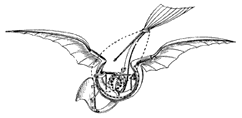
|
|
1870.
Gustave Trouvé flew an ornithopter powered by compressed
air. There are no pictures of that first ornithopter, however.
The ornithopter shown here was flown in 1890. Twelve gunpowder
charges were fired successively into a bourdon tube to flap
the wings, an unusual type of internal combustion engine. The
ornithopter flew 70 meters in a demonstration to the French
Academy of Sciences.
|
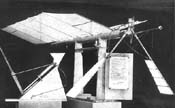
|
|
1890.
Lawrence Hargrave built some ornithopters powered by steam
and compressed air. The ornithopter shown here is about 2
meters long and hangs in the National Air & Space Museum.
Hargrave used a rear fixed wing, like the tail of a bird but
much larger in size and carrying more weight. This eliminated
the need for gear reduction and therefore simplified the construction.
|
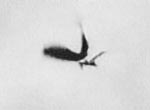
|
|
1930s.
Vincenz Chalupsky built a series of ornithopters that could
be powered either by compressed air or carbon dioxide. These
ornithopters had a birdlike appearance. |
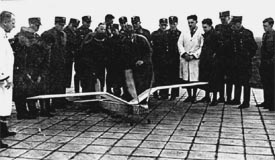
|
|
1930s.
Alexander Lippisch and members of his NSFK group in Germany
constructed a number of piston-driven ornithopters. One of
Lippisch's ornithopters had a 3 meter wingspan and weighed
1950 grams. Using a 4 cc petrol engine, it made flights up
to 16 minutes. Lippisch also designed the Me 163 rocket-powered
fighter aircraft.
|
|
seeking photo
|
|
1935.
In Walden NY around 1935-1936, Early Bird pilot Harry D. Graulich
successfully flew in tethered flight an engine-powered ornithopter
with about a 4.8 meter wingspan. It was powered by a four-cylinder,
air-cooled engine.
|

|
|
1958.
Percival Spencer constructed a series of engine-driven ornithopters
in the shape of a bird. They ranged in size from a small 0.02-engine-powered
ornithopter to one with an eight-foot wingspan. Spencer is also
noted as a pioneer pilot and the designer of the Republic Seabee
amphibious airplane. He also designed a toy, called the Wham-O
Bird, which introduced thousands of children to the idea of
mechanized flapping-wing flight.
|
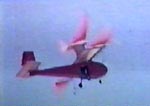
|
|
1960.
Spencer collaborated with Jack Stephenson to build the Orniplane.
This was the first radio-controlled ornithopter. It now resides
at the New England Air Museum in Windsor Locks, CT. Spencer
sought funding to build a manned version. The biplane wing
configuration was to provide a smoother ride for the pilot
and also protected the sensitive early radio equipment. Reportedly,
Spencer's colleague Dale Anderson later converted one of Spencer's
Seagull ornithopters to radio control as well, using the improved
radio equipment of the 1980s.
|
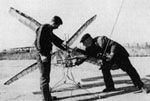
|
|
1984.
Valentin Kiselev's radio controlled, tandem-wing ornithopter
is shown. This ornithopter was powered by an internal combustion
engine. Kiselev also flew some of the first electric ornithopters.
|

|
|
1986.
Despite being underpowered, Paul MacCready's QN pterosaur replica
achieved new levels of realism and demonstrated active stabilization
methods like those used by birds and other flying animals. The
otherwise-unstable ornithopter had an onboard computer to keep
it from going into a spin. The flight path was controlled by
radio. It had a wingspan of 18 feet.
|

|
|
1990.
Horst Räbiger's radio-controlled ornithopter, EV7, was
a technical marvel, using thick-airfoil wings and a pneumatic
spring to provide extra power in the downstroke. In this ornithopter,
the twisting of the wings was actively driven by the motor,
whereas most ornithopter wings twist in response to aerodynamic
forces. |

|
|
1991.
James DeLaurier and Jeremy Harris flew a large radio-controlled
ornithopter, powered by internal combustion. The wing appeared
similar to the EV7's, but it used passive aeroelastic wing twisting.
The news media inaccurately reported this as the first engine-powered,
radio-controlled ornithopter, at a time when few people knew
about the prior successes.
|
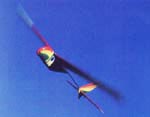
|
|
1998.
Albert Kempf's Truefly ornithopter used electric power and
actively twisted foam wings. Kempf reported that this system
was very energy-efficient. Kempf went on to build some other
ornithopters using a similar mechanism. One of the ornithopters
was made to resemble an eagle and was more realistic looking
than the initial design shown here. |

|
|
1998.
Sean Kinkade's Skybird, based somewhat on the Spencer Seagulls
and using a 0.15 methanol-fueled engine, was an attempt at small-scale
commercial production of an RC ornithopter. Smaller, electric
versions were later offered. Unfortunately, many would-be customers
paid their money and never received the product.
|

|
|
2000.
Some applications for ornithopters rely on their resemblance
to real birds. Intercept Technologies experimentally used radio-controlled
ornithopters for bird control. Styled to look like birds of
prey, the RoboFalcon ornithopters were used to chase flocks
of birds away from airports, where they can pose a threat to
aircraft. |

|
|
2003.
Neuros Company of Korea introduced the first commercially
mass-produced RC ornithopter. Called the Cybird, it was sold
in two different versions. The Cybird P2 had a 39" wingspan
and three-channel radio control. The later-introduced Cybird
P1 had a 29" wingspan and two-channel radio. |

|
|
2007.
Robert Musters began a series of RC ornithopters with foam,
actively twisted wings. The appearance of these ornithopters
is close to that of a real bird and they are being offered for
use in bird control at airports. |
 |
|
2008.
I
built this four-winged RC ornithopter for a demonstration at
IIT Bombay. It represents a concept for a manned ornithopter
at 1/10th scale. The wingspan is 36 inches. The four-winged
design gives this ornithopter excellent slow-flight capabilities,
and it can even be configured for hovering flight. |
Folding
or Articulated Wing Ornithopters

|
|
1930s.
Erich von Holst experimented with various bird and dragonfly
ornithopter configurations. Some of his rubber-powered ornithopters
achieved a very high level of realism. In this one, the outer
wing panels were hinged, to more closely mimic the movement
of a bird's wings. However, the wings could not truely fold
by way of overlapping feathers in the way that a real bird's
wings do. The feathers you see in the picture are merely cosmetic.
|
| |
|
|
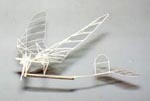
|
|
2004.
Jonathan Howes constructed a bending-wing ornithopter, functionally
similar to von Holst's ornithopter shown above, but much lighter
for indoor flying. It achieved flight times of 4 or 5 minutes,
which is comparable to conventional membrane-winged ornithopters.
Nice job!
|

|
|
2011.
Festo AG announced a radio-controlled ornithopter with bending
wings. They are similar in function to the bending wings of
Erich von Holst, except that the wing twisting (not the bending
action) is driven by a servo motor in each wing. This allows
the amount of wing twist to be adjusted on the fly. |
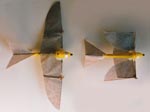 |
|
1997.
My VS1 ornithopter was the first successful implementation of
an ornithopter with true variable-area wings. Instead of multiple
feathers, I used a simplified design with just two overlapping
plates. The plates correspond to the primary and secondary feathers
of a bird's wings and produce a very life-like wing-folding
action. |
I first began
working with ornithopters in the 1980s. At that time, there was
a group called The Ornithopter Modelers' Society. Some of the members
were interested in indoor ornithopter competition, while others
were trying to figure out how to build an ornithopter powered by
an engine instead of a rubber band. We all thought it had never
been done. Gradually, I began to uncover some of the historical
information that you see here. The first engine-powered ornithopters
already existed half a century earlier! I am still picking up new
fragments of ornithopter history, so if you find out about any successful
projects that aren't described on these pages, please let me know!
|
 |



















